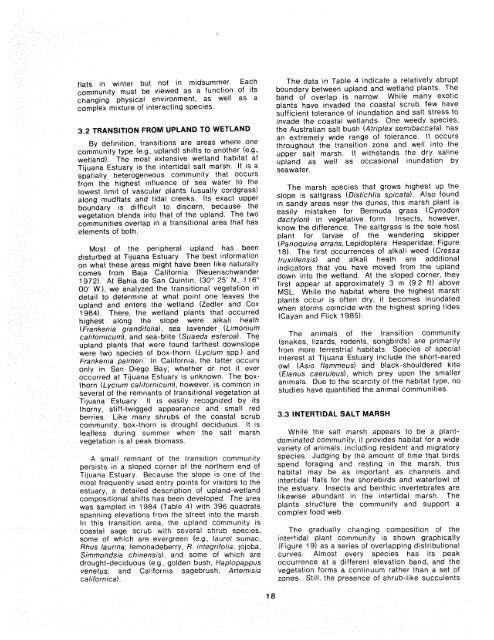The Ecology of Tijuana Estuary, California: An Estuarine Profile
The Ecology of Tijuana Estuary, California: An Estuarine Profile
The Ecology of Tijuana Estuary, California: An Estuarine Profile
Create successful ePaper yourself
Turn your PDF publications into a flip-book with our unique Google optimized e-Paper software.
flats ~n winter but not in midsummer. Each <strong>The</strong> data in Table 4 rndicate a relatively abrupt<br />
community must be mewed as a functron <strong>of</strong> its boundary between upland and wetland plants <strong>The</strong><br />
=hanging physical env~ronment, as well as a band <strong>of</strong> overlap is narrow. While many exotic<br />
complex mixture <strong>of</strong> interacting species<br />
plants have invaded the coastal scrub, few have<br />
sufficient tolerance <strong>of</strong> inundation and salt stress to<br />
invade the coastal wetlands One weedy species,<br />
3.2 TRANSITION f ROM UPLAND TO WET LAND the Australian salt bush (Atnplex sem~baccata), has<br />
an extremely w~de range <strong>of</strong> tolerance It occurs<br />
By def~nltlon, transitlons are areas where One<br />
throughout the transition zone and well into the<br />
community type (eg, upland) shifts to another (eg.9 upper salt marsh It the dry salrne<br />
wetland) <strong>The</strong> most extensrve wetland habitat at Upland as well as occasional by<br />
<strong>Tijuana</strong> <strong>Estuary</strong> is the intertidal salt marsh. It IS a<br />
seawater<br />
spatially heterogeneous community that occurs<br />
from the highest influence <strong>of</strong> sea water to the<br />
lowest lrmlt <strong>of</strong> vascular plants (usually cordgrass)<br />
<strong>The</strong> marsh species that grows highest up the<br />
along mudflats and tidal creeks Its exact upper slope 1s saltgrass (Disfichlls s~rcafa)<br />
boundary is dlffrcu{t to discern, because the<br />
In sandy areas near the dunes. this marsh plant is<br />
vegetation blends into that <strong>of</strong> the upland <strong>The</strong> two eaSrly mistaken Bermuda grass (Cynodon<br />
communities overlap in a transitional area that has dactylon) In vegetative Insects*<br />
elements <strong>of</strong> both.<br />
know the difference <strong>The</strong> saltgrass is the sole host<br />
plant for larvae <strong>of</strong> the wandering skipper<br />
(Panoqurna errans, Lepldoptera: Hesperrdae, Figure<br />
Most Of the upland has been 18) <strong>The</strong> first occurrences <strong>of</strong> alkali weed (Cressa<br />
disturbed at <strong>Tijuana</strong> <strong>Estuary</strong> <strong>The</strong> best lnforrnat~on trux,,,ens,s) and alkali heath are<br />
on what these areas might have been like naturally<br />
that you have moved from the upland<br />
Bala<br />
(Neuenschwander<br />
down into the wetland. At the sloped corner, they<br />
1g72i At de '30u *'' Nr j6" first appear at approx~mately 3 m (9 2 ft) above<br />
00' W.), we analyzed the transitional vegetat~on in<br />
MSL, While the habitat where the marsh<br />
determine at what point One leaves the<br />
plants occur is <strong>of</strong>ten dry, it becomes inundated<br />
up'and and enters the wetland and<br />
when storms coincide with the highest spring tides<br />
1984). <strong>The</strong>re, the wetland plants that occurred<br />
(Cayan and , 985,<br />
highest along the slope were alkali heath<br />
(Frankenla grandrfolra), sea lavender (Llmonrurn<br />
cal~fornrcum), and sea-bllte (Sua.sda esteroa) <strong>The</strong> <strong>The</strong> animals <strong>of</strong> the transition communrty<br />
upland plants that were found farthest downslope (snakes, lizards, rodents, songbirds) are pr~marily<br />
were two species <strong>of</strong> box-thorn (Lyciurn spp ) and from more terrestrial habitats Species <strong>of</strong> special<br />
Flankenla palmeri In <strong>California</strong>, the latter occurs ~nterest at Tiluana <strong>Estuary</strong> include the short-eared<br />
only In Sari olego Bay, whether or not ever OW\ (As10 flarnmeus) and biack-shouldered klte<br />
occurred at <strong>Tijuana</strong> <strong>Estuary</strong> is unknown <strong>The</strong> box.. (Elanus caeruleus), which prey upon the smaller<br />
thorn (Lycrum ca/~fornreu,n), however, is common in anfmals Due to the scarcity Of the habitat type,<br />
several <strong>of</strong> the remnants <strong>of</strong> transitional vegetatron at<br />
have quantified the<br />
<strong>Tijuana</strong> <strong>Estuary</strong> It is eastly recognized by ~ts<br />
thorny, stlff-twigged appearance and small red<br />
berries trke many shrubs <strong>of</strong> the coastal scrub 3.3 iNTERTIDALSALTMARSH<br />
cammunlly, box-thorn is drought deciduous It is<br />
leafless during summer when the salt marsh Whlle the salt marsh appears to be a plantvegetation<br />
is at peak biomass<br />
dominated community, tt prov~des habitat for a wrde<br />
variety <strong>of</strong> anlmals, including resident and migratory<br />
A small remnant <strong>of</strong> the transition cammunity Species Judging by the amount <strong>of</strong> t!me that b~rds<br />
persrsts In a slo~ed corner <strong>of</strong> the northern end <strong>of</strong> spend foraging and resting In the marsh, this<br />
<strong>Tijuana</strong> <strong>Estuary</strong> Because the slope rs One <strong>of</strong> the habitat may be as important as channels and<br />
most frequently used entry po~nts for visitors to the ~ntertidal flats for the shorebirds and waterfowl <strong>of</strong><br />
estuary, a detailed description <strong>of</strong> upland-wetland the estuary. ~nsects and benthrc rnvertebrates are<br />
compositronat shifts has been developed <strong>The</strong> area Ilkewise abundant in the intertidal marsh <strong>The</strong><br />
was sampled in 1984 (Table 4) with 396 quadrats plants structure the communrty and support a<br />
spanning etevatians from the street Into the marsh complex food web<br />
111 this transitron area, the upland commun~ty IS<br />
coastai sage sct%b with several shrub species, <strong>The</strong> gradually changlng composition <strong>of</strong> the<br />
some <strong>of</strong> which are evergreen (eg., laurel sumac, rntertldai plant comrnunrty is shown graphically<br />
Rhus laur~na; lemonadeberry, R tntegrrfoira, jo]oba. (Figure 19) as a serles <strong>of</strong> overlapprng distributtonal<br />
Simmondsra ch!nensrs), and some <strong>of</strong> whrch are curves Almost every species has its peak<br />
drought-dec~duous teg, golden bush, Naplopappus occurrence at a different erevation band, and the<br />
venefus, and Cal~fornia sagebrush, Artemrsta vegetation forms a continuum rather than a set <strong>of</strong><br />
caftfornrca)<br />
zones. Still, the presence <strong>of</strong> shrub-like succulents<br />
18

















